2018 School Spending Survey Report
Good & Plenty: Graphic Novels for K-4
It used to be hard to find good graphic novels for the K–4 crowd. My, how times have changed.
Just a couple of years ago, it was tough to find good graphic novels for the K–4 crowd. Sure, there were some standout selections, such as Andy Runton's Owly, Jimmy Gownley's Amelia Rules!, and Jennifer and Matt Holm's Babymouse, but they were lonely exceptions in a barren landscape. Things quickly changed when publishers realized that the same set that reads (and buys) picture books might also be drawn to graphic novels. Plus, what about the younger brothers and sisters of tween and teen manga readers or superhero fans? Weren't they also a potential new market for graphic novels? These days, children's book and comics publishers offer tons of graphic novels for young readers. In fact, now there are probably too many choices, which, of course, is a nice problem to have. To help you keep up with this explosion, I've selected the cream of the recent crop, focusing on titles that have often been overlooked. To make things more manageable, I've limited my list to graphic novels published within roughly the last 18 months. Also, I didn't include established series, superb titles that aren't stand-alones (sorry, Jellaby), and comics collections. But don't worry. There are still loads of great choices left.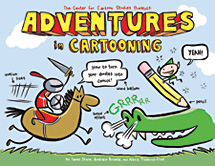 Adventures in Cartooning: How to Turn Your Doodles into Comics. Sturm, James, Andrew Arnold, and Alexis Frederick-Frost. First Second. 2009. $12.95. ISBN 978-1596433694. Almost unbearably clever and inventive, this unusual mix of fiction and nonfiction is deceptively ambitious. Sturm, Arnold, and Frederick-Frost have set out to tell a rip-roaring yarn and to make cartooning user-friendly even for kids who are convinced they can't draw—and they've succeeded on both counts. In addition to offering simple, step-by-step instructions on how to create lively comics, Adventures in Cartooning charts the tale of a knight, an elf, and a horse with a hankering for sweets on the trail of a gum-chewing dragon (and there's a nice surprise ending to boot). This is a unique book that's nothing short of a triumph.
Adventures in Cartooning: How to Turn Your Doodles into Comics. Sturm, James, Andrew Arnold, and Alexis Frederick-Frost. First Second. 2009. $12.95. ISBN 978-1596433694. Almost unbearably clever and inventive, this unusual mix of fiction and nonfiction is deceptively ambitious. Sturm, Arnold, and Frederick-Frost have set out to tell a rip-roaring yarn and to make cartooning user-friendly even for kids who are convinced they can't draw—and they've succeeded on both counts. In addition to offering simple, step-by-step instructions on how to create lively comics, Adventures in Cartooning charts the tale of a knight, an elf, and a horse with a hankering for sweets on the trail of a gum-chewing dragon (and there's a nice surprise ending to boot). This is a unique book that's nothing short of a triumph. 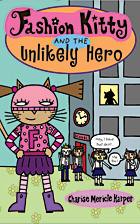 Fashion Kitty and the Unlikely Hero. Harper, Charise Mericle. Hyperion. 2009. $8.99. ISBN 978-0786837274. Yes, this is part of an accomplished ongoing series, but each installment stands on its own, and the series as a whole probably deserves wider recognition. This story, more a mystery than anything else, is a comedic treat from start to finish, as our fashion-conscious feline must figure out why on Earth someone would wear flip-flops and socks. As always, Harper's faux primitive style masks highly sophisticated storytelling: she's structured things to keep readers turning the pages quickly all the way to the satisfying and surprising conclusion.
Fashion Kitty and the Unlikely Hero. Harper, Charise Mericle. Hyperion. 2009. $8.99. ISBN 978-0786837274. Yes, this is part of an accomplished ongoing series, but each installment stands on its own, and the series as a whole probably deserves wider recognition. This story, more a mystery than anything else, is a comedic treat from start to finish, as our fashion-conscious feline must figure out why on Earth someone would wear flip-flops and socks. As always, Harper's faux primitive style masks highly sophisticated storytelling: she's structured things to keep readers turning the pages quickly all the way to the satisfying and surprising conclusion. 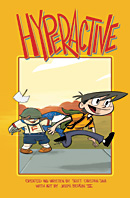 Hyperactive. Sava, Scott Christian and Joseph Bergin. Idea & Design Works. 2008. $12.99. ISBN 978-1600103131. Sava's fertile imagination has resulted in a cottage industry of popular graphic novels for kids, but this is the one that hits the bull's-eye for this age group. For slightly younger readers than Knights of the Lunch Table (see below), this book also happens to feature dodgeball prominently. Wonderfully engaging from the get-go, Hyperactive combines the best of the superhero and day-in-the-life-of-a-school-kid genres.
Hyperactive. Sava, Scott Christian and Joseph Bergin. Idea & Design Works. 2008. $12.99. ISBN 978-1600103131. Sava's fertile imagination has resulted in a cottage industry of popular graphic novels for kids, but this is the one that hits the bull's-eye for this age group. For slightly younger readers than Knights of the Lunch Table (see below), this book also happens to feature dodgeball prominently. Wonderfully engaging from the get-go, Hyperactive combines the best of the superhero and day-in-the-life-of-a-school-kid genres. 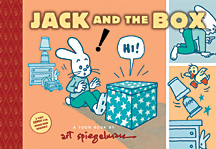 Jack and the Box. Spiegelman, Art. Toon Bks. 2008. $12.95. ISBN 978-0979923838. While several of the Toon titles probably deserve a place on this list, I'm singling this one out because it's thoughtfully aimed at very young readers, an underserved audience. Spiegelman keeps the story appropriately straightforward while slowly heading toward the gleefully anarchic tone that made many of Dr. Seuss's books so memorable. But Spiegelman does other noteworthy things as well. Using an entire page as a panel, he maintains the sequential flavor of comics but with the big, open visuals of a picture book. He also manages to keep a phonics emphasis, repeating key sounds in a manner that makes Jack and the Box even more of a gift to emergent readers.
Jack and the Box. Spiegelman, Art. Toon Bks. 2008. $12.95. ISBN 978-0979923838. While several of the Toon titles probably deserve a place on this list, I'm singling this one out because it's thoughtfully aimed at very young readers, an underserved audience. Spiegelman keeps the story appropriately straightforward while slowly heading toward the gleefully anarchic tone that made many of Dr. Seuss's books so memorable. But Spiegelman does other noteworthy things as well. Using an entire page as a panel, he maintains the sequential flavor of comics but with the big, open visuals of a picture book. He also manages to keep a phonics emphasis, repeating key sounds in a manner that makes Jack and the Box even more of a gift to emergent readers.  Johnny Boo: The Best Little Ghost in the World. Kochalka, James. Top Shelf. 2008. $9.95. ISBN 978-1603090131. Ready for the scoop? Johnny Boo and his ghost pet Squiggle are terrified of the Ice Cream Monster. Still, that doesn't mean they can't all eventually become friends. This landmark book for the kindergarten crowd is just as much fun for adults to read aloud as it is for kids to listen to. With its simple, childlike art (which may leave some youngsters wondering if they could have created the illustrations), Johnny Boo is sweet without being sugary and comfortably familiar yet fresh on every page. All in all, Kochalka's light touch has created the quintessential small gem.
Johnny Boo: The Best Little Ghost in the World. Kochalka, James. Top Shelf. 2008. $9.95. ISBN 978-1603090131. Ready for the scoop? Johnny Boo and his ghost pet Squiggle are terrified of the Ice Cream Monster. Still, that doesn't mean they can't all eventually become friends. This landmark book for the kindergarten crowd is just as much fun for adults to read aloud as it is for kids to listen to. With its simple, childlike art (which may leave some youngsters wondering if they could have created the illustrations), Johnny Boo is sweet without being sugary and comfortably familiar yet fresh on every page. All in all, Kochalka's light touch has created the quintessential small gem. 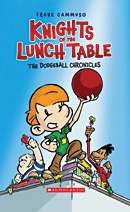 Knights of the Lunch Table (The Dodgeball Chronicles). Cammuso, Frank. GRAPHIX. 2008. $9.95. ISBN 978-0439903226. Artie's first day at Camelot Middle School can't get much worse. He inadvertently irritates Principal Dagger and provokes the school bully. Mr. Merlyn springs a pop quiz in science class, and the local gang issues a dodgeball challenge. While children's and YA lit seem to be filled with high-concept conceits these days—“What if Beowulf were set at a day camp?”—this is one of the few titles that pulls it off in admirable fashion. Maybe that's because Cammuso's bold colors, assured storytelling, and superb character development make this series opener a hit even without the Camelot subtext. And although this humorous schoolyard romp deals with middle school, we all know who reads about middle schoolers: kids in fourth and fifth grade.
Knights of the Lunch Table (The Dodgeball Chronicles). Cammuso, Frank. GRAPHIX. 2008. $9.95. ISBN 978-0439903226. Artie's first day at Camelot Middle School can't get much worse. He inadvertently irritates Principal Dagger and provokes the school bully. Mr. Merlyn springs a pop quiz in science class, and the local gang issues a dodgeball challenge. While children's and YA lit seem to be filled with high-concept conceits these days—“What if Beowulf were set at a day camp?”—this is one of the few titles that pulls it off in admirable fashion. Maybe that's because Cammuso's bold colors, assured storytelling, and superb character development make this series opener a hit even without the Camelot subtext. And although this humorous schoolyard romp deals with middle school, we all know who reads about middle schoolers: kids in fourth and fifth grade. 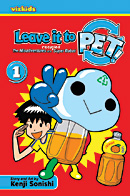 Leave It to PET! Volume One. Sonishi, Kenji. VIZ Media. 2009. $7.99. ISBN 978-1421526492. The phrase for “all ages” is overused by marketers and often exasperating for the rest of us, but it's true this time around. Every single member of my family laughed out loud while reading this hilarious account of a recycled plastic bottle that's transformed into a bungling do-gooder super-robot named PET. Despite the robot's best intentions to assist nine-year-old Noburo (in gratitude for recycling him!), PET can't help wreaking gentle havoc. Tightly written and with brilliant cartooning from Sonishi, this is an undeniable winner that kids won't be able to resist sharing with their peers… and parents.
Leave It to PET! Volume One. Sonishi, Kenji. VIZ Media. 2009. $7.99. ISBN 978-1421526492. The phrase for “all ages” is overused by marketers and often exasperating for the rest of us, but it's true this time around. Every single member of my family laughed out loud while reading this hilarious account of a recycled plastic bottle that's transformed into a bungling do-gooder super-robot named PET. Despite the robot's best intentions to assist nine-year-old Noburo (in gratitude for recycling him!), PET can't help wreaking gentle havoc. Tightly written and with brilliant cartooning from Sonishi, this is an undeniable winner that kids won't be able to resist sharing with their peers… and parents. 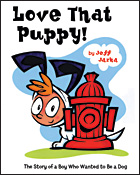 Love That Puppy! The Story of a Boy Who Wanted to Be a Dog. Jarka, Jeff. Holt. 2009. $12.95. ISBN 978-0805087413. Like a true canine, Peter barks, chases the mailman, and plays fetch. There's just one problem: Peter isn't a dog; he's a boy. Jarka's simple premise is so powerful—a little boy pretends to be a puppy to get his parents' attention—it makes one wonder why it's never been done before. This book is probably most often shelved in the picture-book section, but guess what? It's a bona fide comic. And with its large, full-page panels, it's a terrific choice for introducing very young readers to the world of graphic novels.
Love That Puppy! The Story of a Boy Who Wanted to Be a Dog. Jarka, Jeff. Holt. 2009. $12.95. ISBN 978-0805087413. Like a true canine, Peter barks, chases the mailman, and plays fetch. There's just one problem: Peter isn't a dog; he's a boy. Jarka's simple premise is so powerful—a little boy pretends to be a puppy to get his parents' attention—it makes one wonder why it's never been done before. This book is probably most often shelved in the picture-book section, but guess what? It's a bona fide comic. And with its large, full-page panels, it's a terrific choice for introducing very young readers to the world of graphic novels. 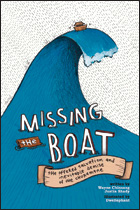 Missing the Boat. Shady, Justin, Wayne Chinsang, and Dwellephant. Image Comics. 2009. ISBN 978-1607060154. A real rarity nowadays: a true cautionary tale for children. In that sense, it's refreshing even in its darkness. A tale about a species that, out of sheer sloth, does not survive the great flood, Missing the Boat reminds us that Noah's Ark isn't really about cute animals on a fun boat ride but about cataclysm on a massive scale. Some of the nuances of dialog might be better appreciated by older readers, but the humor—and overall message—are not apt to be lost on anyone.
Missing the Boat. Shady, Justin, Wayne Chinsang, and Dwellephant. Image Comics. 2009. ISBN 978-1607060154. A real rarity nowadays: a true cautionary tale for children. In that sense, it's refreshing even in its darkness. A tale about a species that, out of sheer sloth, does not survive the great flood, Missing the Boat reminds us that Noah's Ark isn't really about cute animals on a fun boat ride but about cataclysm on a massive scale. Some of the nuances of dialog might be better appreciated by older readers, but the humor—and overall message—are not apt to be lost on anyone. 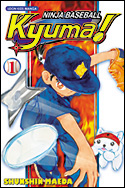 Ninja Baseball Kyuma! Volume One. Maeda, Shunshin. Udon. $7.99. ISBN 978-1897376867. Ninjas and baseball? Hey, isn't that a little gimmicky? Well, sure, but that doesn't mean it's not one heck of a read. All of Udon's kids' manga is worth checking out, but this tale of a young ninja boy who's accidentally recruited by a little league team is arguably a grand slam. Although Ninja Baseball Kyuma! relies on stock manga elements—like intense rivalries and mysterious figures (one chapter is even entitled “The Suspicious Bearded Man”)—Maeda's deft, creative touch makes this a pitch-perfect choice for young readers.
Ninja Baseball Kyuma! Volume One. Maeda, Shunshin. Udon. $7.99. ISBN 978-1897376867. Ninjas and baseball? Hey, isn't that a little gimmicky? Well, sure, but that doesn't mean it's not one heck of a read. All of Udon's kids' manga is worth checking out, but this tale of a young ninja boy who's accidentally recruited by a little league team is arguably a grand slam. Although Ninja Baseball Kyuma! relies on stock manga elements—like intense rivalries and mysterious figures (one chapter is even entitled “The Suspicious Bearded Man”)—Maeda's deft, creative touch makes this a pitch-perfect choice for young readers. 
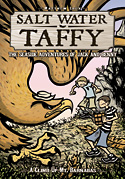 Salt Water Taffy, Volume One: The Legend of Old Salty. Loux, Matthew. Oni. 2008. $5.95. ISBN 978-1932664942. Salt Water Taffy, Volume Two: A Climb Up Mt. Barnabus. Loux, Matthew. Oni. 2008. $5.95 ISBN 978-1934964033. When brothers Jack and Benny arrive in coastal Chowder Bay, ME, the two are sure they're in for a snoozer of a summer. But that all changes when they come across the legend of a local sea monster and a giant eagle flies off with their father's lucky hat, forcing the boys to trek up a treacherous mountain to retrieve it. Briskly paced and written, these “seaside adventures” feel like classics in the making, and each volume can be enjoyed independently. Benny, 8, and Jack, 11, perfectly bookend the ages for which this series is intended. And who can resist lines like “I wish I could punch Maine in the face”?
Salt Water Taffy, Volume One: The Legend of Old Salty. Loux, Matthew. Oni. 2008. $5.95. ISBN 978-1932664942. Salt Water Taffy, Volume Two: A Climb Up Mt. Barnabus. Loux, Matthew. Oni. 2008. $5.95 ISBN 978-1934964033. When brothers Jack and Benny arrive in coastal Chowder Bay, ME, the two are sure they're in for a snoozer of a summer. But that all changes when they come across the legend of a local sea monster and a giant eagle flies off with their father's lucky hat, forcing the boys to trek up a treacherous mountain to retrieve it. Briskly paced and written, these “seaside adventures” feel like classics in the making, and each volume can be enjoyed independently. Benny, 8, and Jack, 11, perfectly bookend the ages for which this series is intended. And who can resist lines like “I wish I could punch Maine in the face”? 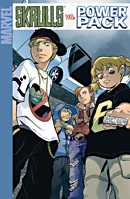 Skrulls vs. Power Pack. Van Lente, Fred, and Cory Hamscher. Marvel Comics. 2009. $9.95. ISBN 978-0785132851. I'm a big fan of Power Pack, the four young siblings who do battle across the universe. In this tale, the Skrulls (shape-shifting aliens who are Marvel's ever-reliable villains) have taken on the appearance of Power Pack while the superheroes are imprisoned on another planet. Chock-full of humor and action that's exciting without being too harrowing, this book is ideal for fourth graders. However, whenever the authors of this series stray into full-on science fiction territory, or need to deal with characters such as Tony Stark (aka Iron Man) or Bruce Banner (the Hulk), the vocabulary level shoots skyward. Still, that's not necessarily a bad thing, especially for fourth graders who can use the visual and textual context clues and who are into expanding their vocabularies.
Skrulls vs. Power Pack. Van Lente, Fred, and Cory Hamscher. Marvel Comics. 2009. $9.95. ISBN 978-0785132851. I'm a big fan of Power Pack, the four young siblings who do battle across the universe. In this tale, the Skrulls (shape-shifting aliens who are Marvel's ever-reliable villains) have taken on the appearance of Power Pack while the superheroes are imprisoned on another planet. Chock-full of humor and action that's exciting without being too harrowing, this book is ideal for fourth graders. However, whenever the authors of this series stray into full-on science fiction territory, or need to deal with characters such as Tony Stark (aka Iron Man) or Bruce Banner (the Hulk), the vocabulary level shoots skyward. Still, that's not necessarily a bad thing, especially for fourth graders who can use the visual and textual context clues and who are into expanding their vocabularies. 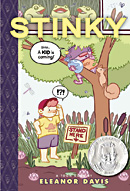 Stinky. Davis, Eleanor. Toon Bks. 2008. $12.95. ISBN 978-0979923845. Stinky the swamp monster is scared of kids. And who can blame him? After all, humans eat apples and cake (gross!) rather than wallowing in the mud and wolfing down pickled onions. Davis's Theodor Seuss Geisel Honor Book offers a heartfelt message about sharing and friendship, and she masterfully uses a variety of text types, including labels and words that are seamlessly integrated with the art (check out the characters' T-shirts). The real showstoppers, though, are the word-balloon shapes and lettering, which are bound to inspire first and second graders to become more expressive oral readers. (Full disclosure: I created the lesson plans for Stinky, and I've worked on lesson plans for some of Toon's other books.)
Stinky. Davis, Eleanor. Toon Bks. 2008. $12.95. ISBN 978-0979923845. Stinky the swamp monster is scared of kids. And who can blame him? After all, humans eat apples and cake (gross!) rather than wallowing in the mud and wolfing down pickled onions. Davis's Theodor Seuss Geisel Honor Book offers a heartfelt message about sharing and friendship, and she masterfully uses a variety of text types, including labels and words that are seamlessly integrated with the art (check out the characters' T-shirts). The real showstoppers, though, are the word-balloon shapes and lettering, which are bound to inspire first and second graders to become more expressive oral readers. (Full disclosure: I created the lesson plans for Stinky, and I've worked on lesson plans for some of Toon's other books.) 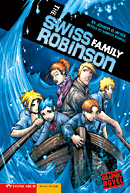 The Swiss Family Robinson. Wyss, Johann D., Martin Powell, and art by Gerardo Sandoval. Stone Arch. 2008. $23.93. ISBN 978-1434207562. Many of Stone Arch's adaptations of classics, with their heavy themes and low vocabulary levels, are perfect for struggling older readers. Fortunately, this one is just as appropriate for second and third graders—and no less exciting. The simplified version of Johann D. Wyss's adventure tale retains the original kid-friendly story's plucky spirit, and with its slick production values, it's bound to appeal to fans of superhero comics. The supplementary discussion questions, writing prompts, and glossary are welcome bonuses for any library collection.
The Swiss Family Robinson. Wyss, Johann D., Martin Powell, and art by Gerardo Sandoval. Stone Arch. 2008. $23.93. ISBN 978-1434207562. Many of Stone Arch's adaptations of classics, with their heavy themes and low vocabulary levels, are perfect for struggling older readers. Fortunately, this one is just as appropriate for second and third graders—and no less exciting. The simplified version of Johann D. Wyss's adventure tale retains the original kid-friendly story's plucky spirit, and with its slick production values, it's bound to appeal to fans of superhero comics. The supplementary discussion questions, writing prompts, and glossary are welcome bonuses for any library collection. 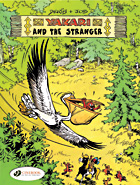 Yakari and the Stranger. Derib and art by Job. Cinebook. 2008. $11.95. ISBN 978-1905460274. Though this graphic novel was technically released a little more than 18 months ago, its publisher is so poorly known in North America that Yakari and the Stranger, and Cinebook's other titles, will come as news to many. Based in the UK, Cinebook translates classic Belgian comics into English, often those first published decades ago. Yakari and the Stranger is but one title in a Disney-esque series about a Native American boy and his forest friends. Here, a lost pelican becomes the springboard for a cute-but-serious fable about accepting outsiders that's told with considerable skill and charm.
Yakari and the Stranger. Derib and art by Job. Cinebook. 2008. $11.95. ISBN 978-1905460274. Though this graphic novel was technically released a little more than 18 months ago, its publisher is so poorly known in North America that Yakari and the Stranger, and Cinebook's other titles, will come as news to many. Based in the UK, Cinebook translates classic Belgian comics into English, often those first published decades ago. Yakari and the Stranger is but one title in a Disney-esque series about a Native American boy and his forest friends. Here, a lost pelican becomes the springboard for a cute-but-serious fable about accepting outsiders that's told with considerable skill and charm. RELATED
RECOMMENDED
CAREERS
The job outlook in 2030: Librarians will be in demand
CAREERS
The job outlook in 2030: Librarians will be in demand
ALREADY A SUBSCRIBER? LOG IN
We are currently offering this content for free. Sign up now to activate your personal profile, where you can save articles for future viewing






Add Comment :-
Be the first reader to comment.
Comment Policy:
Comment should not be empty !!!